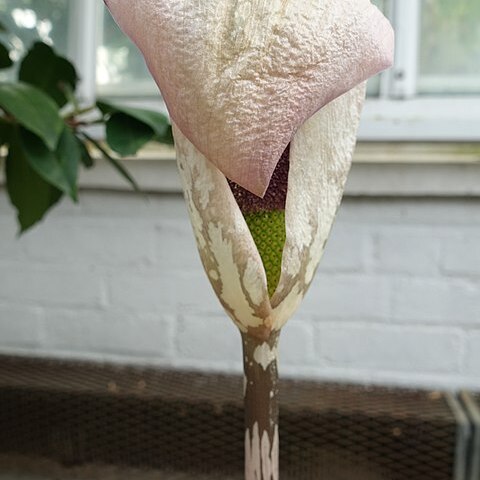Tuber dark brown, white or yellow inside, depressed globose, to 9 cm high, to 13 cm in diam., weighing up to 500 g, root scars with an annular thickening, seasonally developing several offsets; offsets sessile, rounded or elliptic, ca. 2.5 × to 1.2 cm. Leaf solitary; cataphylls 3, dark grayish green, largely covered with pale pinkish, rhombic spots, 6-35 cm; petiole medium to dark olive-green or dark olive-brown with several rhombic or narrowly elliptic, pale whitish greenish spots, 10-80 cm, 0.5-2.5 cm in diam. at base, glabrous; leaf blade highly dissected, to 190 cm in diam.; rachises broadly winged except below basal branching points, basal branching points sometimes developing intercalary bulbils after disturbance; leaflets abaxially paler, adaxially dark green, often with a bluish sheen when young, margin often narrowly violet, elliptic, 10-40 × 5-13 cm, base broadly decurrent, apex acuminate. Inflorescence solitary, long pedunculate; cataphylls as with leaf; peduncle colored as petiole, 13-60 cm, 1-2 cm in diam. at base. Spathe shortly convolute at base, erect, concave, arching over spadix, outside white or pale greenish white, rarely dark green, sometimes near base with paler, occasionally ringlike spots, or sometimes flushed with pale pinkish, margin sometimes lined pinkish, inside pale greenish white without spots; limb outside dirty creamish, sometimes with faint spots, margin sometimes pale pinkish violet, inside ± cream-colored or pale greenish white, margin sometimes pale pinkish violet, broadly ovate, 9-29 × 4-20 cm, inside base glabrous or with a few scattered, punctiform warts, apex obtuse or acute. Spadix creamy white or pale pinkish, much shorter than spathe, 3-18 cm; stipe pale green with whitish spots, 0.5-2.5 cm; flowers unisexual; female zone cylindric, slightly conic or obconic, 0.8-3.5 × 0.5-2 cm, flowers congested but in proximal part sometimes loosely arranged; ovary green, pale green, brownish green, or purplish, near style insertion sometimes dirty creamish, globose, subglobose, or depressed, orbicular or angulate in outline, 2-2.5 mm high, 2-4 mm in diam., 2-loculed; style straight or curved, green or dirty pale pinkish, narrowly to broadly conic, base (articulation) thickened, 1-2.5 × 0.3-1 mm; stigma pale yellowish or dirty brownish, variable, usually distinctly broader than style diam., disciform to subhemispheric, more rarely superficial, punctiform, orbicular or oval in outline, with a shallow central depression to clearly 2-lobed, verrucate; lobes rounded, 0.4-0.6 mm high, 0.6-1.2 mm in diam.; male zone conic or fusiform-cylindric, rarely obconic, sometimes (partly) laterally compressed, 1-4 × 0.6-3.5 cm, flowers congested; male flowers consisting of 3-5 stamens; stamens 3-3.5 mm; filaments 0.5-2 mm, basally or up to 2/3 of length connate; anthers creamy white, 1.5-3 × 1-2 mm; connectives flat or with a ridgelike extension, perpendicular to long axis, either small or very large, maroon or dark brown; pores apical, elongate; appendix ovoid, conic, or triangular-ovoid, rarely subcylindric, inflated or strongly laterally compressed, 3-11 × 1.5-5 cm, glabrous or verruculose, rarely entirely echinate, often with a few longitudinal shallow or deep, broad folds, or irregularly folded throughout, base strongly truncate, apex obtuse, rarely acute, usually with a few broadly conic staminodes. Infructescence cylindric or subglobose, 4-11 × 3.5-5 cm, dried male zone and appendix often remaining, as well as dried spathe. Berries 1-or 2-seeded, at first green, at maturity turning blue and finally violet, at apex with dried style and stigma remaining. Fl. Apr-May.
More
A herb. It is a root crop. The tuber is dark brown. It is white or yellow inside. It is 13 cm across and 9 cm high and a flattened round shape. It develops offsets 2.5 cm long by 1.5 cm wide. There is one leaf. The leaf stalk is 10-80 cm tall and 1-2.5 cm wide. The leaf blade is highly divided and 190 cm across. The leaflets are more pale underneath. The leaflets are 10-40 cm long by 5-13 cm wide. The flower stalk is 13-60 cm long by 1-2 cm wide. The spathe arches over the flower. The flower spadix is creamy white.

